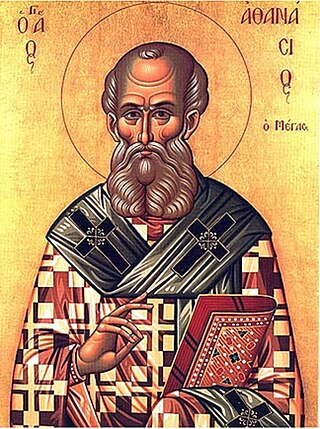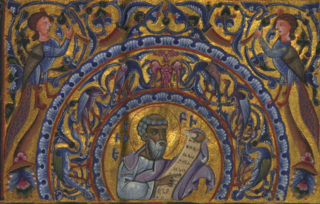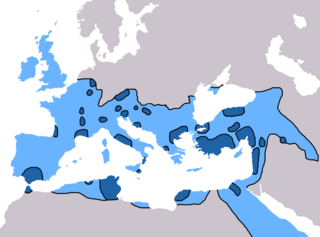Related Research Articles

Athanasius I of Alexandria, also called Athanasius the Great, Athanasius the Confessor, or, among Coptic Christians, Athanasius the Apostolic, was a Christian theologian and the 20th pope of Alexandria. His intermittent episcopacy spanned 45 years, of which over 17 encompassed five exiles, when he was replaced on the order of four different Roman emperors. Athanasius was a Church Father, the chief proponent of Nicene theology against the anti-Nicenes, and a noted Egyptian Christian leader of the fourth century.

Anthony the Great was a Christian monk from Egypt, revered since his death as a saint. He is distinguished from other saints named Anthony, such as Anthony of Padua, by various epithets: Anthony of Egypt, Anthony the Abbot, Anthony of the Desert, Anthony the Anchorite, Anthony the Hermit, and Anthony of Thebes. For his importance among the Desert Fathers and to all later Christian monasticism, he is also known as the Father of All Monks. His feast day is celebrated on 17 January among the Eastern Orthodox and Catholic churches and on Tobi 22 in the Coptic calendar.

Eusebius of Caesarea, also known as Eusebius Pamphilus, was a Greek Syro-Palestinian historian of Christianity, exegete, and Christian polemicist. In about AD 314 he became the bishop of Caesarea Maritima in the Roman province of Syria Palaestina. Together with Pamphilus, he was a scholar of the biblical canon and is regarded as one of the most learned Christians during late antiquity. He wrote Demonstrations of the Gospel, Preparations for the Gospel and On Discrepancies between the Gospels, studies of the biblical text. As "Father of Church History", he produced the Ecclesiastical History, On the Life of Pamphilus, the Chronicle and On the Martyrs. He also produced a biographical work on Constantine the Great, the first Christian Roman emperor, who was Augustus between AD 306 and AD 337.

The First Council of Constantinople was a council of Christian bishops convened in Constantinople in AD 381 by the Roman Emperor Theodosius I. This second ecumenical council, an effort to attain consensus in the church through an assembly representing all of Christendom, except for the Western Church, confirmed the Nicene Creed, expanding the doctrine thereof to produce the Niceno-Constantinopolitan Creed, and dealt with sundry other matters. It met from May to July 381 in the Church of Hagia Irene and was affirmed as ecumenical in 451 at the Council of Chalcedon.

Pachomius, also known as Saint Pachomius the Great, is generally recognized as the founder of Christian cenobitic monasticism. Coptic churches celebrate his feast day on 9 May, and Eastern Orthodox and Catholic churches mark his feast on 15 May or 28 May. In Lutheranism, he is remembered as a renewer of the church, along with his contemporary, Anthony of Egypt on 17 January.

Basil of Caesarea, also called Saint Basil the Great, was a bishop of Caesarea Mazaca in Cappadocia, Asia Minor. He was an influential theologian who supported the Nicene Creed and opposed the heresies of the early Christian church, fighting against both Arianism and the followers of Apollinaris of Laodicea.

The Armenian Rite is a liturgical rite used by both the Armenian Apostolic and the Armenian Catholic churches. Isaac of Armenia, the Catholicos of All Armenians, initiated a series of reforms with help from Mesrop Mashtots in the 5th century that distinguished Armenia from its Greek and Syriac counterparts. These reforms included a retranslation of the Bible and a revised liturgy. During the Crusades and afterwards, missionary activity by the Latin Church influenced liturgical norms and induced some Armenians to join the Catholic Church. The modern Armenian Rite features elements and interpolations from the Byzantine Rite and Latin liturgical rites, with the celebration of the Eucharist emulating the Liturgy of Saint Basil.

Basilian monks are Greek Catholic monks who follow the rule of Basil the Great, bishop of Caesarea (330–379). The term 'Basilian' is typically used only in the Catholic Church to distinguish Greek Catholic monks from other forms of monastic life in the Catholic Church. In the Eastern Orthodox Church, as all monks follow the Rule of Saint Basil, they do not distinguish themselves as 'Basilian'.
The Patrologia Graeca is an edited collection of writings by the Church Fathers and various secular writers, in the Greek language. It consists of 161 volumes produced in 1857–1866 by J.P. Migne's Imprimerie Catholique, Paris.

Seeing Islam As Others Saw It: A Survey and Evaluation of Christian, Jewish and Zoroastrian Writings on Early Islam from the Studies in Late Antiquity and Early Islam series is a book by scholar of the Middle East Robert G. Hoyland.
Athanasius II Baldoyo, also known as Athanasius of Balad, and Athanasius of Nisibis, was the Patriarch of Antioch and head of the Syriac Orthodox Church from 684 until his death in 687.

The Order of Saint Basil the Great, also known as the Basilian Order of Saint Josaphat, is a Greek Catholic monastic order of pontifical right that works actively among Ukrainian Catholics and other Greek-Catholic churches in central and Eastern Europe. The order received approbation on August 20, 1631, and is based at the Monastery of the Holy Trinity, Vilnius.

Coptic literature is the body of writings in the Coptic language of Egypt, the last stage of the indigenous Egyptian language. It is written in the Coptic alphabet. The study of the Coptic language and literature is called Coptology.

Coptic history is the part of the history of Egypt that begins with the introduction of Christianity in Egypt in the 1st century AD during the Roman period, and covers the history of the Copts to the present day. Many of the historic items related to Coptic Christianity are on display in many museums around the world and a large number is in the Coptic Museum in Coptic Cairo.

Christianity in the 4th century was dominated in its early stage by Constantine the Great and the First Council of Nicaea of 325, which was the beginning of the period of the First seven Ecumenical Councils (325–787), and in its late stage by the Edict of Thessalonica of 380, which made Nicene Christianity the state church of the Roman Empire.
Athanasius I Gammolo was the Patriarch of Antioch and head of the Syriac Orthodox Church from 594/595 or 603 until his death in 631. He is commemorated as a saint by the Syriac Orthodox Church in the Martyrology of Rabban Sliba, and his feast day is 3 January.

Admonitio ad filium spiritualem is an anonymous Latin "manual of spiritual edification" written around the year 500. During the Middle Ages, it was believed to be a translation by Rufinus of Aquileia of a Greek original by Basil of Caesarea. It is now thought to be an original Latin composition, most likely by Porcarius of Lérins. Its author is still known conventionally as Pseudo-Basil.
Serapion of Nitria, Serapion of Thmuis, also spelled Sarapion, or Serapion the Scholastic was an early Christian monk and bishop of Thmuis in Lower Egypt, born in the 4th century. He is notable for fighting alongside Athanasius of Alexandria against Arianism.
The Historia monachorum in Aegypto, also called the Lives of the Desert Fathers, is a combination travelogue and hagiography from the late 4th century AD. It recounts the travels of a band of seven Palestinian monks on a pilgrimage through Egypt between September 394 and January 395. They travelled from south to north, stopping in monasteries and meeting hermits and holy men. The Historia is in essence a collection of stories about these men and their miracles.

Copto-Arabic literature is the literature of the Copts written in Arabic. It is distinct from Coptic literature, which is literature written in the Coptic language.
References
Bibliography
- Fedwick, Paul Jonathan, ed. (1981). Basil of Caesarea, Christian, Humanist, Ascetic: A Sixteen-Hundredth Anniversary Symposium. Pontifical Institute of Mediaeval Studies.